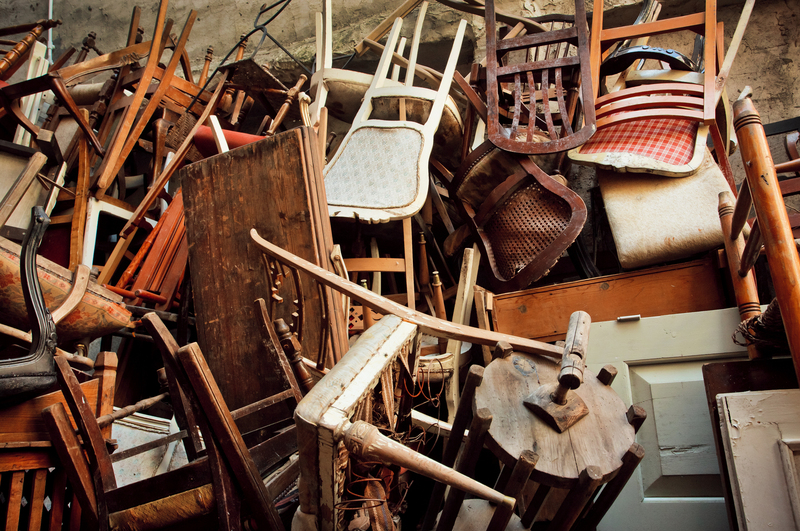Step-by-Step Guide to Storing a Freezer When Unplugged
If you're planning to store your freezer while it's unplugged, whether for a seasonal move, renovation, or simply to save electricity, it's essential to follow the correct procedures. Improper storage can result in unpleasant odors, mold growth, and even damage that can shorten the lifespan of your appliance. In this comprehensive guide, you'll discover effective, practical steps to safely and efficiently store your freezer when it's not in use.
Why Proper Freezer Storage Matters
Freezers are large appliances that can be costly to repair or replace. Ensuring that your freezer is stored properly while unplugged:
- Prevents mold, mildew, and odors.
- Protects the interior and exterior from damage.
- Preserves the appliance for future use.
- Helps maintain energy efficiency.
Let's get started with this thorough step-by-step guide to storing a freezer when unplugged!

Preparation Before Unplugging Your Freezer
1. Plan Ahead
Always plan your timing so you can carry out the storage process when the freezer is empty and clean. Make sure you have enough time to complete each step without rushing.
2. Clear Out All Food and Contents
- Remove all food items from your freezer; never leave anything inside.
- Dispose of or relocate any remaining contents to avoid spoilage or unwanted odors.
Tip: Use coolers or insulated bags to temporarily store frozen goods while you clean and prepare your freezer for storage.
3. Unplug the Freezer Safely
- Turn off and unplug your freezer from the power outlet.
- Allow the appliance to begin defrosting naturally.
Step-by-Step Cleaning Process
4. Defrost the Freezer Completely
- Leave the door open and allow time for all ice to melt from the interior walls and freezer box.
- Place towels or a shallow pan to catch melting ice and water, preventing floor damage.
Tip: For quicker defrosting, place bowls of hot (not boiling) water inside the freezer to generate steam.
5. Thoroughly Wipe Down All Surfaces
- With the unit defrosted, use a solution of warm water and mild dish soap to clean all interior and exterior surfaces.
- Pay close attention to corners, seals, and crevices where spills or mold may accumulate.
Don't forget: Clean shelves, drawers, and compartments individually outside of the freezer, then thoroughly dry before replacing.
6. Sanitize to Kill Bacteria and Odors
- Prepare a non-toxic sanitizing solution (one tablespoon baking soda per quart of water works well).
- Wipe every part of the freezer, including gaskets, walls, and drawers, to neutralize bacteria and prevent future odors.
- Allow the surfaces to dry completely with the freezer door open.
Alternatively, you can use a solution of vinegar and water for sanitization.
Final Preparation for Storage
7. Dry the Freezer Completely
- It's crucial that all internal and external surfaces are bone dry to prevent mildew and rust.
- Leave the door open for a minimum of 24 hours, longer if possible.
- Set a small fan near the freezer to help speed up the drying process.
Moisture is the main enemy when storing a freezer unplugged, as it can lead to unwanted mold and rust.
8. Protect the Freezer Door Gasket
- Apply a light coat of petroleum jelly or mineral oil to the door seal/gasket to prevent drying, cracking, or sticking.
Tip: A healthy door seal ensures your freezer remains energy efficient and airtight when put back into use.
9. Store Components Separately (If Possible)
- If your freezer includes removable shelves, bins, or trays, store them separately to promote air flow and prevent mold.
- Make sure each part is completely dry before packing away.
Choosing The Right Location for Freezer Storage
10. Find a Dry, Well-Ventilated Space
- Store your unplugged freezer in a location that is dry, cool, and away from direct sunlight.
- Avoid damp basements, outdoor sheds without temperature control, or areas with drastic temperature swings.
- Ensure the space is ventilated to prevent moisture build-up and unwanted odors inside the freezer.
11. Keep the Freezer Door Ajar
- Never close the freezer door completely during storage--this prevents air flow and can create a musty, moldy environment inside.
- Use a towel, piece of cardboard, or a specially designed appliance wedge to keep the door slightly open.
This is one of the most crucial steps when storing a freezer unplugged!
12. Protect the Exterior
- Cover the unplugged freezer with a breathable dust cover, old sheet, or moving blanket--never plastic, which can trap moisture.
- This defends the surface from dust and scratches during its time in storage.
Mold, Moisture & Odor Prevention Tips
13. Use Odor Absorbers Inside
- Place an open box of baking soda, activated charcoal, or a commercial odor absorber on a freezer shelf to keep things smelling fresh.
- Replace every few months for maximum effectiveness.
14. Periodically Inspect the Freezer
- Check your stored appliance every month or so for any signs of moisture, mildew, pests, or smells.
- Wipe away any condensation and refresh odor absorbers as needed.
Prevention is always easier than remediation when it comes to keeping your freezer in optimal condition during storage.
Reinstalling or Returning Your Freezer to Use
15. Cleaning Before Plugging Back In
- When it's time to use your freezer again, give it a quick wipe-down with baking soda solution or mild cleaner.
- Check the gasket, shelves, and plug for any sign of wear or damage.
- Let the unit air out for a few hours before plugging in and loading with food.
16. Power Up Safely
- Plug the freezer directly into a wall outlet without using extension cords (these can lead to overheating).
- Allow the freezer to cool to the desired temperature before adding any items.
- Check for unusual noises or leaks--these can signal issues after extended storage and might require expert assistance.
Common Mistakes to Avoid When Storing a Freezer Unplugged
- Leaving the door closed tightly. (Encourages mold and musty smells.)
- Storing in a damp or non-ventilated area.
- Forgetting to remove all moisture.
- Using airtight plastic wraps for covering.
- Neglecting periodic checks during the storage period.
Key Takeaways
- Empty, clean, and fully dry your freezer before unplugging for storage.
- Keep the door ajar and use an odor absorber to prevent mold and smells.
- Choose a dry, ventilated spot for storage--avoid humid spaces.
- Inspect regularly during storage to catch issues early.
- Clean and check components before returning your freezer to use.
Following these steps will ensure your freezer works efficiently and safely when you need it again!

Frequently Asked Questions About Storing a Freezer Unplugged
Can I store a freezer unplugged for a long period?
Yes, freezers can be stored safely for months or even years if all moisture is removed and the door remains slightly open. Ensure the location is dry and adequately ventilated.
Should the freezer door be open or closed during storage?
Always prop the door open. A closed door can trap moisture and lead to mold or mildew, while a slightly open door maintains ventilation.
How can I prevent freezer odors when storing it unplugged?
Clean and sanitize the interior before storing, and use odor absorbers (like baking soda or charcoal) inside the compartment.
Is it safe to store a freezer in a garage or shed?
Generally yes, as long as the space is well-ventilated, dry, and sheltered from extreme temperature fluctuations. Avoiding damp areas is crucial for long-term appliance health.
Do I need to cover a freezer in storage?
You don't need a plastic wrap; instead, use a breathable cotton sheet or old blanket to protect from dust and scratching.
Conclusion: Store Your Freezer Unplugged With Confidence
With these step-by-step instructions and tips, you can store your unplugged freezer safely while extending its lifespan and keeping it ready for future use. Whether you're protecting a chest freezer, upright freezer, or compact unit, these best practices will help you maintain functionality and hygiene while minimizing the risk of damage.
Remember: A little time spent on proper freezer storage pays dividends in convenience and savings when it's time to plug your appliance back in. Follow these steps and rest assured your freezer is safely stored!



